Unit 7 What’s the highest mountain in the world Section B(1a-ld)PPT课件+内嵌视频 -人教新目标八年级英语下册
文档属性
| 名称 | Unit 7 What’s the highest mountain in the world Section B(1a-ld)PPT课件+内嵌视频 -人教新目标八年级英语下册 | 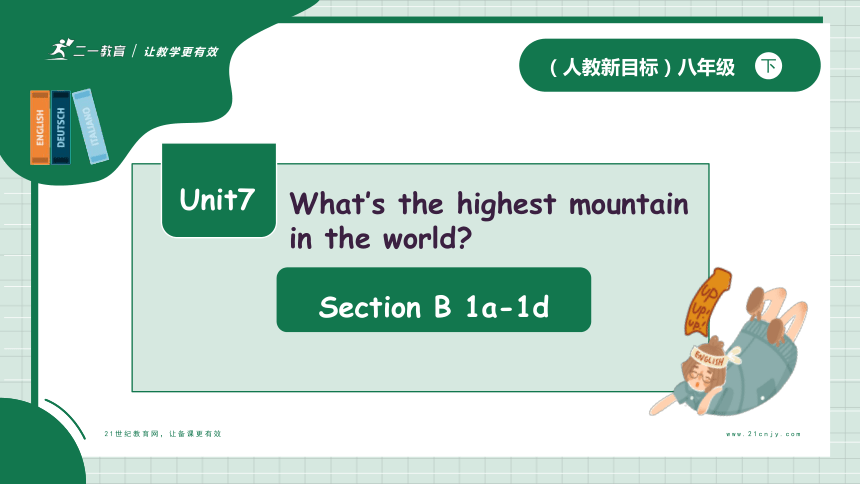 | |
| 格式 | pptx | ||
| 文件大小 | 85.1MB | ||
| 资源类型 | 试卷 | ||
| 版本资源 | 人教新目标(Go for it)版 | ||
| 科目 | 英语 | ||
| 更新时间 | 2025-04-11 10:27:15 | ||
图片预览

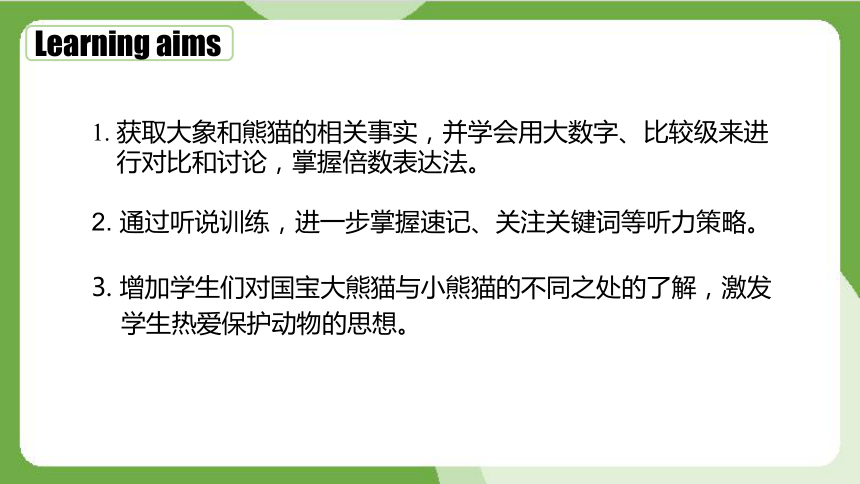

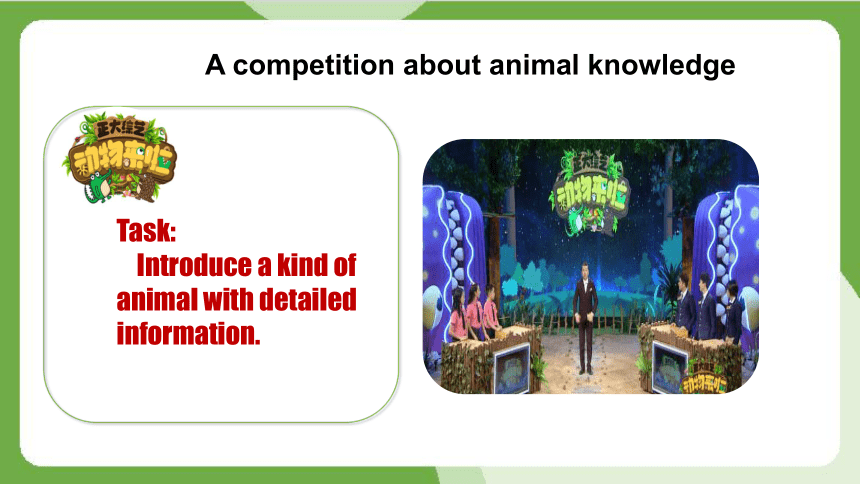

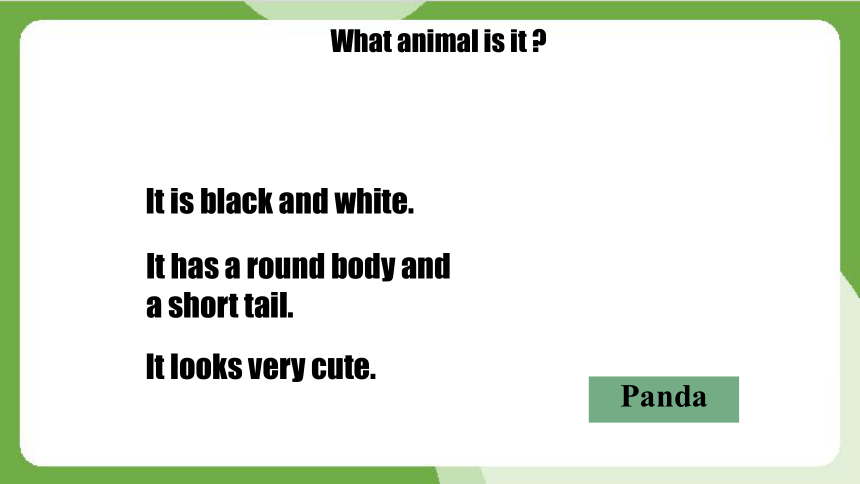

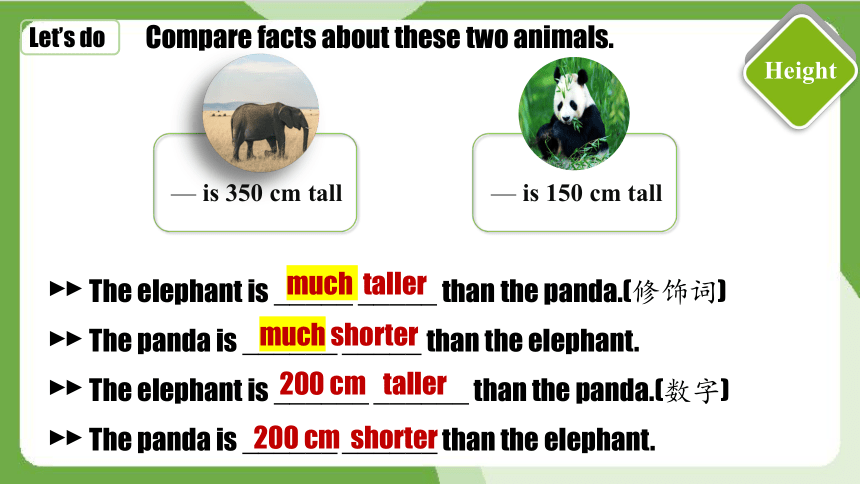
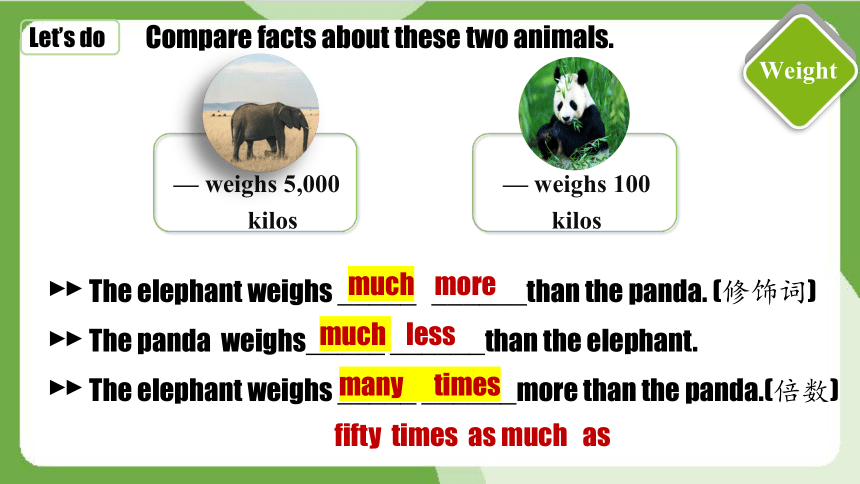
文档简介
(共24张PPT)
(人教新目标)八年级
下
Section B 1a-1d
What’s the highest mountain in the world
Unit7
1. 获取大象和熊猫的相关事实,并学会用大数字、比较级来进
行对比和讨论,掌握倍数表达法。
2. 通过听说训练,进一步掌握速记、关注关键词等听力策略。
3. 增加学生们对国宝大熊猫与小熊猫的不同之处的了解,激发
学生热爱保护动物的思想。
Learning aims
A competition about animal knowledge
Task:
Introduce a kind of animal with detailed information.
What animal is it
It is very big .
It has two long teeth .
It has a long nose .
It has two big ears.
Elephant
Let’s guess
It has a round body and
a short tail.
It is black and white.
It looks very cute.
Panda
What animal is it
How much do you know about them
friend
strong
endangered
popular
symbol
The elephant is _____ _____ than the panda.(修饰词)
The panda is ______ _____ than the elephant.
The elephant is ______ ______ than the panda.(数字)
The panda is ______ ______ than the elephant.
Compare facts about these two animals.
— is 350 cm tall
— is 150 cm tall
Height
much taller
much shorter
200 cm taller
200 cm shorter
Let’s do
The elephant weighs _____ ______than the panda. (修饰词)
The panda weighs_____ ______than the elephant.
The elephant weighs _____ ______more than the panda.(倍数)
Compare facts about these two animals.
— weighs 5,000
kilos
— weighs 100 kilos
Weight
much more
much less
many times
Let’s do
fifty times as much as
The elephant eats ______ ______ than the panda.(修饰语)
The panda eats _____ ______ than the elephant.
The elephant eats ______ ______ more than the panda.(倍数)
Compare facts about these two animals.
— eats 150kilos of
food a day
— eats 10kilos of
food a day
Food
much more
much less
many times
Let’s do
fifteen times as much as
20
0.2
16
0.1
sixteen
zero point two
twenty
zero point one
150
100
120
50
one hundred and twenty
one hundred
one hundred and fifty
fifty
Let’s read
Listen and check (√) the numbers you hear.
______ 100 ______ 16 ______ 20 ______ 50
______ 120 ______ 0.1 ______ 0.2 ______ 150
√
听前读数,
快速锁定答案
1b
Let’s listen
What is a panda like
when it's born
Let's learn more facts about baby pandas.
Listen again and complete the sentences.
1.At birth, a baby panda is about ______ to ______ kilos.
2.At birth, a baby panda is about ______ cm long.
3.A baby panda is not black. It is ______ and it has no ______.
4.A panda can live up to ______ to ______ years.
听前读关键词,
快速定位答案
活到…岁
0.1
0.2
15
pink
teeth
20
30
1c
Weight
Size
Looks
Life
出生时
The adult pandas weigh around ______ kilos.
1000
An adult panda is around _________ long.
150 cm
Let’s listen
Make ID cards for pandas.
Name:__________
Weight: ________
Length:______________
Color:______________
Food: _____________
Other interesting facts:
______________________
Name:__________
Weight: ________
Length:______________
Color:______________
Food: _____________
Other interesting facts:
_______________________
Let’s practice
0.1 to 0.2 kilos
around 15 cm long
pink
can’t see, has no teeth
milk
about 100 kilos
around 150 cm long
black and white
can live up to 20 to 30 years
bamboo
baby panda
adult panda
Pair work
— weighs 0.1 to 0.2 kilos
— around 15 cm long
— pink
— milk
— can’t see and has no teeth
— weighs about 100 kilos
— around 150 cm long
— black and white
— bamboo
— can live up to 20 to 30 years
Try to use facts and comparatives to introduce pandas.
Example:
A: How heavy/ long is .... /How much does...weigh/eat
B: It only weighs about... kilos. / It is...long.
It weighs much less /many times less than an adult panda.
A: What else do you know about it
A baby panda weighs _____ ____ less than an adult panda .
A baby panda weighs _____ ____less than an adult panda .
A baby panda is ______ _____ than an adult panda.
A baby panda is ______ ______ than an adult panda.
1000 times
many times
135cm shorter
much shorter
Let’s watch a video and learn more about baby pandas.
After listening
Further thinking
A
The growth of pandas
Life is amazing!
Respect life!
Task:
Introduce a kind of animal with detailed information.
How can we introduce an animal
What’s the animal
What’s it like
What does it feed on
Where does it live
...
Weight
Size
Looks
Respect
Group work
Choose one animal to introduce.
Love
Protect
Homework
1. Try to describe an animal with the facts
and comparatives.
2. Search for more information about wild
animals online and make a report.
Thank you
(人教新目标)八年级
下
Section B 1a-1d
What’s the highest mountain in the world
Unit7
1. 获取大象和熊猫的相关事实,并学会用大数字、比较级来进
行对比和讨论,掌握倍数表达法。
2. 通过听说训练,进一步掌握速记、关注关键词等听力策略。
3. 增加学生们对国宝大熊猫与小熊猫的不同之处的了解,激发
学生热爱保护动物的思想。
Learning aims
A competition about animal knowledge
Task:
Introduce a kind of animal with detailed information.
What animal is it
It is very big .
It has two long teeth .
It has a long nose .
It has two big ears.
Elephant
Let’s guess
It has a round body and
a short tail.
It is black and white.
It looks very cute.
Panda
What animal is it
How much do you know about them
friend
strong
endangered
popular
symbol
The elephant is _____ _____ than the panda.(修饰词)
The panda is ______ _____ than the elephant.
The elephant is ______ ______ than the panda.(数字)
The panda is ______ ______ than the elephant.
Compare facts about these two animals.
— is 350 cm tall
— is 150 cm tall
Height
much taller
much shorter
200 cm taller
200 cm shorter
Let’s do
The elephant weighs _____ ______than the panda. (修饰词)
The panda weighs_____ ______than the elephant.
The elephant weighs _____ ______more than the panda.(倍数)
Compare facts about these two animals.
— weighs 5,000
kilos
— weighs 100 kilos
Weight
much more
much less
many times
Let’s do
fifty times as much as
The elephant eats ______ ______ than the panda.(修饰语)
The panda eats _____ ______ than the elephant.
The elephant eats ______ ______ more than the panda.(倍数)
Compare facts about these two animals.
— eats 150kilos of
food a day
— eats 10kilos of
food a day
Food
much more
much less
many times
Let’s do
fifteen times as much as
20
0.2
16
0.1
sixteen
zero point two
twenty
zero point one
150
100
120
50
one hundred and twenty
one hundred
one hundred and fifty
fifty
Let’s read
Listen and check (√) the numbers you hear.
______ 100 ______ 16 ______ 20 ______ 50
______ 120 ______ 0.1 ______ 0.2 ______ 150
√
听前读数,
快速锁定答案
1b
Let’s listen
What is a panda like
when it's born
Let's learn more facts about baby pandas.
Listen again and complete the sentences.
1.At birth, a baby panda is about ______ to ______ kilos.
2.At birth, a baby panda is about ______ cm long.
3.A baby panda is not black. It is ______ and it has no ______.
4.A panda can live up to ______ to ______ years.
听前读关键词,
快速定位答案
活到…岁
0.1
0.2
15
pink
teeth
20
30
1c
Weight
Size
Looks
Life
出生时
The adult pandas weigh around ______ kilos.
1000
An adult panda is around _________ long.
150 cm
Let’s listen
Make ID cards for pandas.
Name:__________
Weight: ________
Length:______________
Color:______________
Food: _____________
Other interesting facts:
______________________
Name:__________
Weight: ________
Length:______________
Color:______________
Food: _____________
Other interesting facts:
_______________________
Let’s practice
0.1 to 0.2 kilos
around 15 cm long
pink
can’t see, has no teeth
milk
about 100 kilos
around 150 cm long
black and white
can live up to 20 to 30 years
bamboo
baby panda
adult panda
Pair work
— weighs 0.1 to 0.2 kilos
— around 15 cm long
— pink
— milk
— can’t see and has no teeth
— weighs about 100 kilos
— around 150 cm long
— black and white
— bamboo
— can live up to 20 to 30 years
Try to use facts and comparatives to introduce pandas.
Example:
A: How heavy/ long is .... /How much does...weigh/eat
B: It only weighs about... kilos. / It is...long.
It weighs much less /many times less than an adult panda.
A: What else do you know about it
A baby panda weighs _____ ____ less than an adult panda .
A baby panda weighs _____ ____less than an adult panda .
A baby panda is ______ _____ than an adult panda.
A baby panda is ______ ______ than an adult panda.
1000 times
many times
135cm shorter
much shorter
Let’s watch a video and learn more about baby pandas.
After listening
Further thinking
A
The growth of pandas
Life is amazing!
Respect life!
Task:
Introduce a kind of animal with detailed information.
How can we introduce an animal
What’s the animal
What’s it like
What does it feed on
Where does it live
...
Weight
Size
Looks
Respect
Group work
Choose one animal to introduce.
Love
Protect
Homework
1. Try to describe an animal with the facts
and comparatives.
2. Search for more information about wild
animals online and make a report.
Thank you
同课章节目录
- Unit 1 What's the matter?
- Section A
- Section B
- Unit 2 I'll help to clean up the city parks.
- Section A
- Section B
- Unit 3 Could you please clean your room?
- Section A
- Section B
- Unit 4 Why don't you talk to your parents?
- Section A
- Section B
- Unit 5 What were you doing when the rainstorm came
- Section A
- Section B
- Review of Units 1-5
- Unit 6 An old man tried to move the mountains.
- Section A
- Section B
- Unit 7 What's the highest mountain in the world?
- Section A
- Section B
- Unit 8 Have you read Treasure Island yet?
- Section A
- Section B
- Unit 9 Have you ever been to a museum?
- Section A
- Section B
- Unit 10 I've had this bike for three years.
- Section A
- Section B
